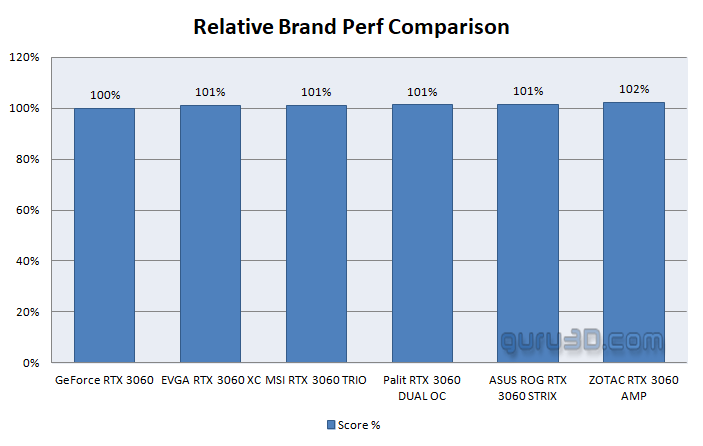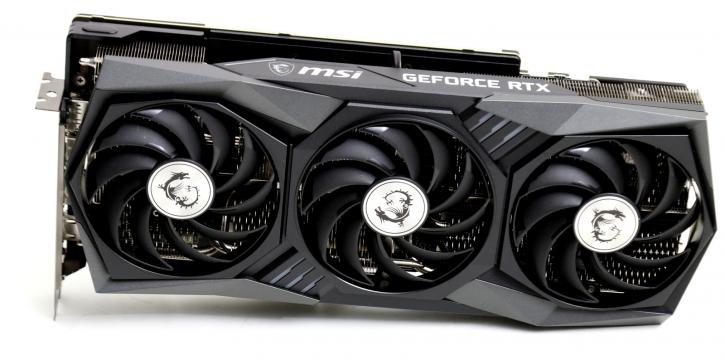Final words and conclusion
Final words
The RTX 3060 in general first. If only the GeForce RTX 3060 could be purchased for the advertised 329 USD, it would be an attractive product. However, we have to face the fact that the world is a place with cryptocurrency miners hogging every GPU they can get their hands on, chip shortages, and COVID, increasing the demand for home PC gaming. All these variables create a silly mix of shortages and raised prices. For the 3060 NVIDIA did implement a restriction for miners, hopefully, it'll help. The card series performance itself is decent, at best. We do want to note that the performance fluctuated quite a bit per game title. Overall I'd say the direct competitors are RTX 2070, and team Red's Radeon RX 5700 series are close in performance (though lacking DXR/DLSS/12GB). We had hopes that NVIDIA would have enabled the full shader processor stack, they didn't, and as such sometimes we feel the performance to be a little dim for something at this price level. The GeForce RTX 3060 Ti for this fact alone, absolutely would have my preference over the non-Ti mode, even with fewer graphics memory. Realistically the GeForce RTX 3060 is a product series we can still recommend if the price is right; 300 to 350 USD is steep for something with x060 in its name.
The above plot is a spread over five cards we have tested, NVIDIA did not release a reference product so the base RTX 3060 entry was simply downclocked to reference values. This however reveals a performance differential of roughly 1 or 2% on a spread of games at 2560x1440. Depending on resolution and game application, maybe you'd hit 3%. This means the (average) difference between the reference and fastest cards is roughly 2 maybe 3 FPS based on a 100 FPS average spread.
It does, however, offer performance levels in that RTX 2070 range, with the added benefit of 12 GB GDDR6 graphics memory included, and that I deem to be a sweet spot for the gamers that have a monitor with a resolution of up to 2560x1440. For some easier on the GPU gaming titles, Ultra HD as well. Once again, NVIDIA brings the advantage of DLSS, something that AMD is sorely missing on the latest 6000 series. It gives NVIDIA the resources of creating a leap in performance, as you do not need to run any form of antialiasing over the rasterizer/shading engine. That's a win any time in my book, as it's cheap extra performance. Be wary of DLSS, though; only quality DLSS 2.0 modes I deem worth it; otherwise, image corruption will be visible quite fast. Let's take Cyberpunk 2077:
Above: Ultra DLSS performance mode
Above: Quality performance mode
As you can see, there is substantial image degradation when selecting the DLSS ultra-performance mode. The grid in the back shows moire effects, also focus on the girl's shadow to the left. Also, the lettering on that metal plate behind the girl is much fuzzier. It is an incredible dilemma. Play around with the setting if you have an NVIDIA RTX graphics card and see for yourself what you deem to be acceptable. It ain't perfect, but it will free up your graphics processor, which can be used and utilized for other stuff.
The MSI GeForce RTX 3060 Gaming X TRIO then. Let's face it; it's a classic design that looks good and performs well at all levels. Let's break it down.
Cooling & noise levels
You've seen the FLIR images; it's not even lighting up. Temps under stress load sit just at 61 degrees C, and that's delightful. Acoustics wise this card is a gem; 30 DBa was measured; you cannot hear that if you're further than 30cm away from the card.
Energy
More recently, we changed the way we measure power consumption to bring you more precise numbers. Pulling manufacturer registers with, say, Afterburner creates the problem that you never know precisely what you are measuring. TGP versus TDP versus TBP. With our new methodology, we accurately measure the graphics card's power feeds, that's the PCIe PEG connectors and PCI-Slot. As such, we display the total board power. I mean, you can measure the GPU solely (TGP), but you also feed other components, like Memory ICs, and let's not forget cooling and RGB. This card reveals a typical gaming power draw of 175 Watt averaged out.
Coil whine
The TRIO X did well; coil whine was very hard to detect, minor at best. You cannot hear this when seated inside a closed chassis.
Pricing
NVIDIA is pricing the GeForce RTX 3060 at USD 329. We have not yet received the MSRP for the gaming TRIO X, but knowing MSI, this product is a premium design, however at the time of writing MSI could not supply an MSRP. But with a predicted low availability, it's hard to really make a factual statement here if prices inflate due to e-tailers hiking up prices. We heard the RTX 3060 VENTUS 3X 12G OC is going to sell at $469,- and that would mean the TRIO is more expensive. We can never justify or approve such pricetags for something with x060 in its name, never.
Tweaking
The graphics card is tweaked right out of the box. But can be pushed further manually. You'll reach 16 to 16.5 Gbps on the memory, a +100 MHz on the Boost, and for the lucky ones even a notch higher (that's on top of that factory tweak). Important, slide open the power limiter. More power budget allows the GPU to do what it likes to do the best, go fast. Combined with the tweaks mention on the OC page, you'll sit in the realm of 2000~2050 MHz on the boost frequency. The 3060 is memory bandwidth limited on that 192-bit wide memory bus, so it likes more air to breathe in. the tweak we've been able to apply was 1.72 Gbps (effective data-rate) here you'll gain a lot of extra performance. combined with that turbo in the 2000~2050MHz domain. Remember that values differ per workload and thus the game title. Remember, for our tweak to be called valid, it needs to pass four games in a full benchmark run at Ultra HD to be called stable.
Conclusion
The market really needs graphics cards like the GeForce RTX 3060, but never has that same market been so complicated due to shortages based on various reasons. That is what it is; we'll, as such, focus on the price, features, quality, and performance in the hope that in the coming months, prices will; become sane and normal again. That's said, in the 300 to 350 USD range, the price on the 3060 is very steep; however, I could warrant it solely based on your framebuffer; the 12 GB GDDR6 is really nice value that will help you at least a few years, but the GPU likes more bandwidth though, 192-bit is a notch too little. The performance does not disappoint though; I mean, roughly RTX 2070 levels is the best comparison that I can make, for AMD that's the 5700 (XT) performance level. If you stick to 2560x1440 as a resolution, you'll be able to play some games with Hybrid raytracing as well, and while we cannot care the slightest bit about raytraced shadows, it's the quality reflections that make the difference for me. Just drive around in London in Watch Dogs: Legion, looks at water and fire reflections in Battlefield V as an example; that's where it makes a difference. You're going to need DLSS 2.0 compatibility in games to make the best of it. But all these variables have been inserted into the RTX 3060 for you. Surely the card is not a powerhouse, but you can frag along with acceptable framerates. At an AIB level then, MSI nailed it in design and performance. The design however is perhaps overkill for that this product would be, a mainstream graphics card. At baseline defaults, the card would be a notch faster than a reference clocked product (which NVIDIA did not release). When manually tweaked, you'll gain another ~5% in performance. What remains impressive with these MSI products is that the graphics card remains so incredibly silent, shockingly quiet. It does all that with peak GPU temperatures that remain under 65 Degrees C. This is a product that I like as it offers proper performance at WQHD levels for us ordinary folk. Not just that, you'll have the added benefit of playing some games with hybrid raytracing, as well as the fact that NVIDIA has Tensor cores onboard, offering more perf at complex workloads with DLSS. All-in-all, the GeForce RTX 3060 series brings you towards RTX 2070 performance levels. The 12GB I find to be a desirable value making this product the new sweet spot in that even more recent mid-range. MSI certainly did it right; the design, cooling and acoustic performance, and a good tweakability value will bring their product towards a top pick.
As a product design, this is a top pick; which would be based on variables like build quality, aesthetics, acoustics, and temps. However, I need to factor out pricing though. Brutal honesty, we're currently struggling if we should even add awards at such price levels. But we'll add one based on what I just wrote, but do so with a conflicted mind.
Sign up to receive a notification when we publish a new article.
Or go back to Guru3D's front page
- Hilbert, LOAD"*",8,1.






